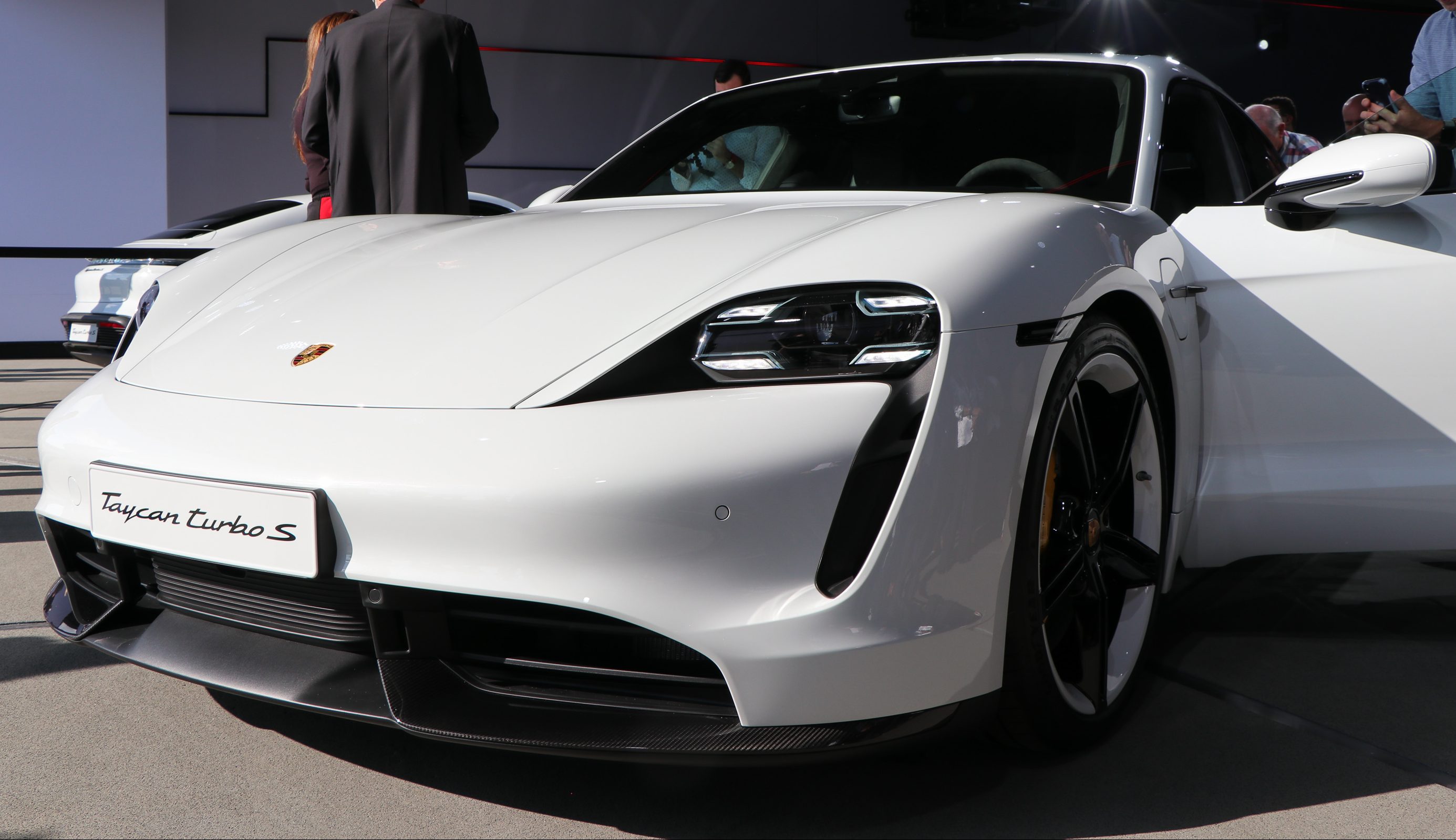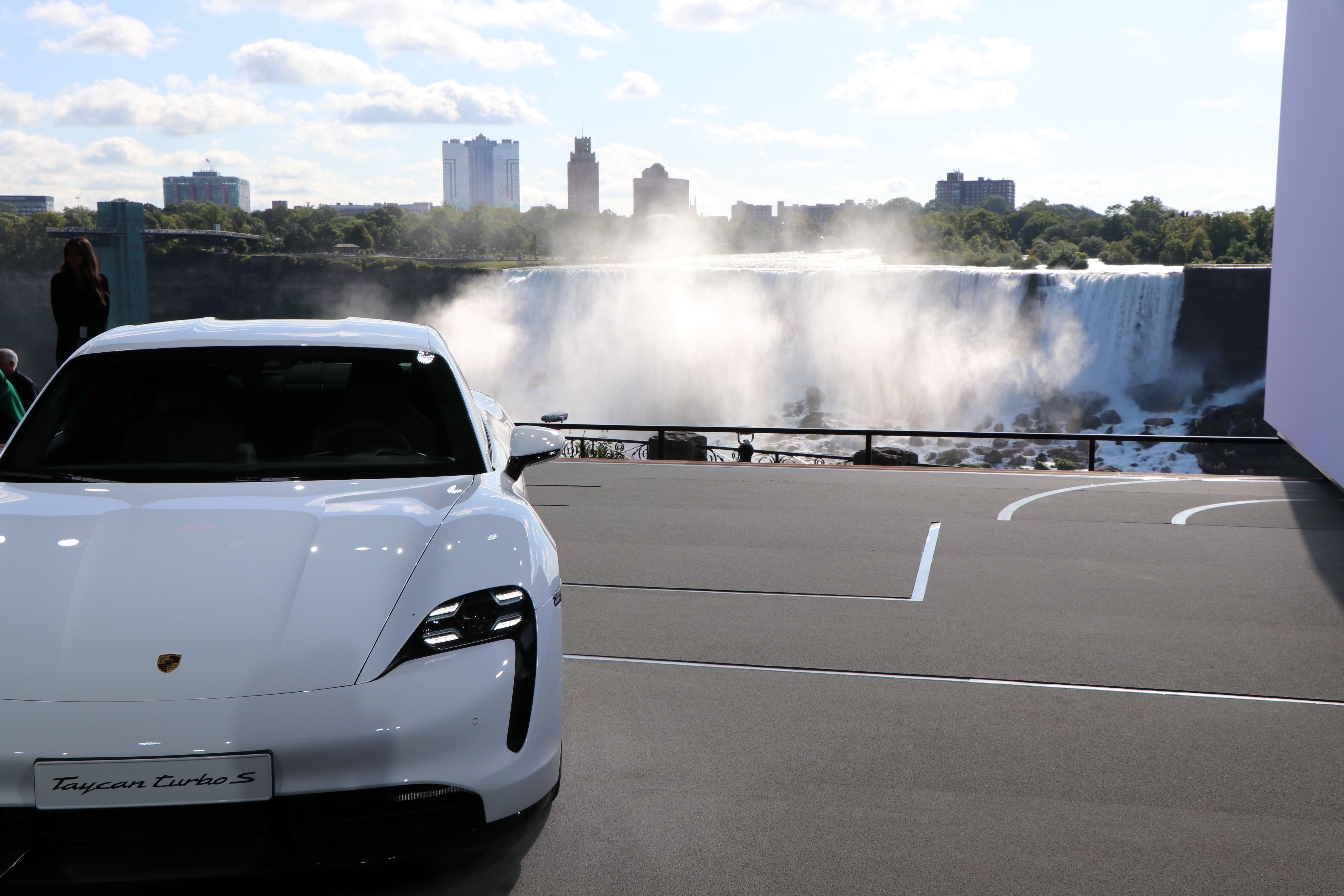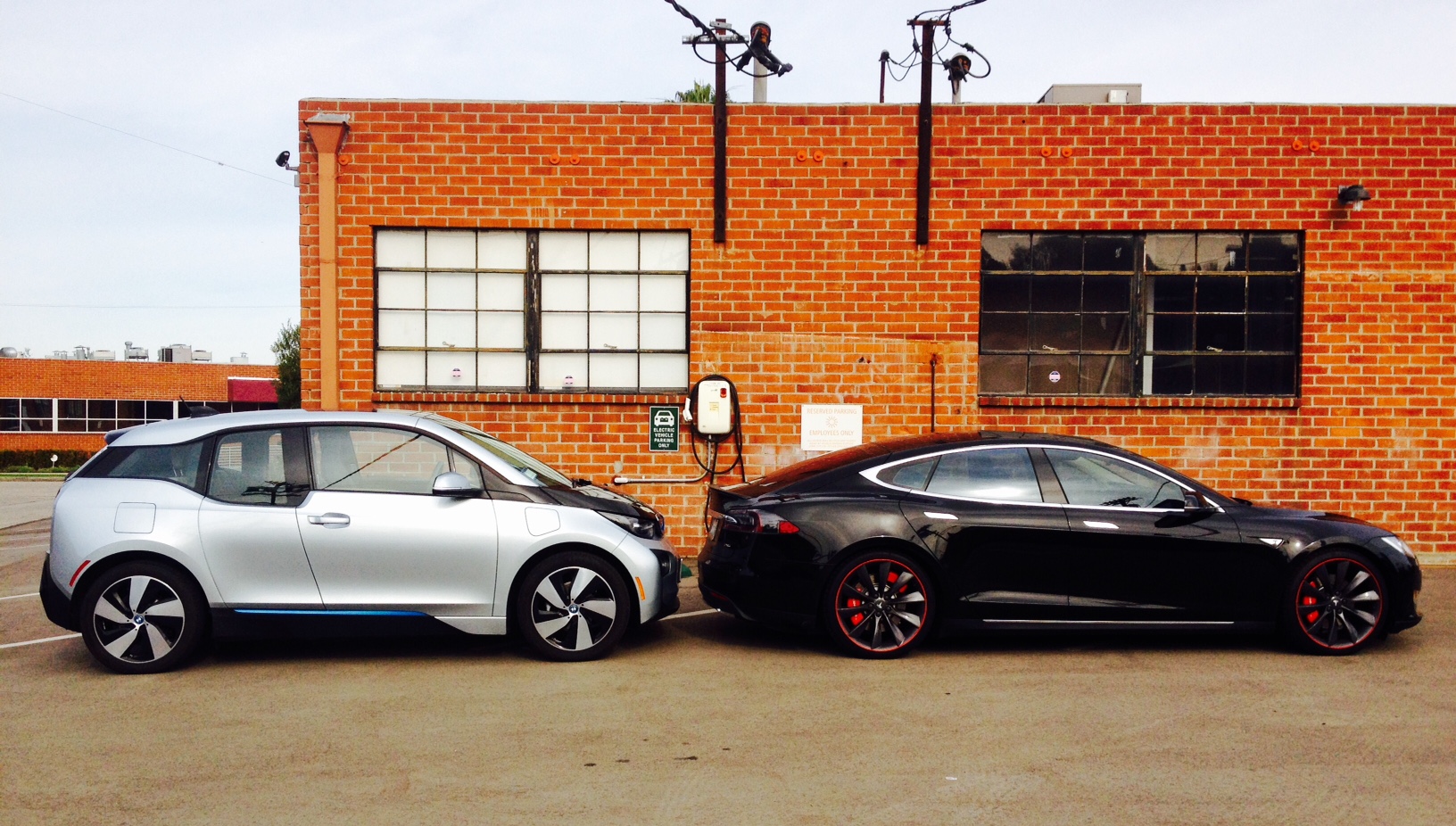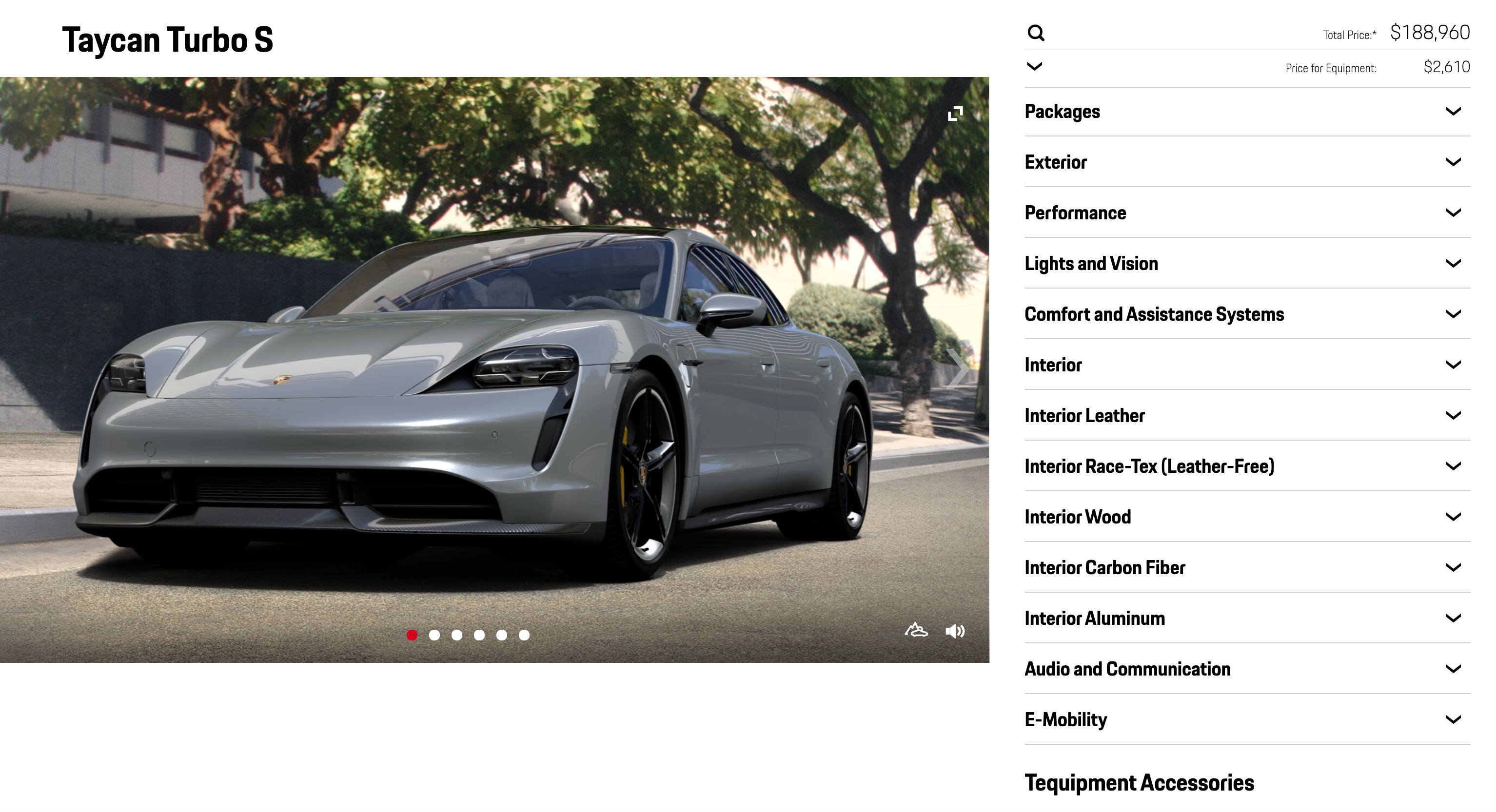

News
Porsche Taycan isn’t supposed to be a Tesla. Stop it.
Our tryst was short but, truth be told, I, a very happy Tesla owner, haven’t stopped thinking about the Porsche Taycan ever since the day we shared something special together.
It was a day of passion, driven by irrational thinking. Under the guise of a regular four-door sedan whose interior was garbed in strategically placed dark strips of cloth – clearly aimed at hiding the wolf within – it was soon obvious that I was no match for this beast.
“Do you want another go?”
It was an emphatic “no” from me to Porsche’s Platform Director for the Taycan, Bernd Propfe, as I climbed out of a production-ready Turbo S mule, and made every attempt to fight back obvious signs of nausea mixed with an overdose of adrenaline-induced shakes. Having just experienced a series of 720-degree donuts, high-speed drifts, 0-60 mph blasts in 2.6 seconds, followed by what can only be described as multiple time attack sessions on Porsche’s 1.6-mile circuit in Atlanta, the last thing I needed was to hear anyone belabor the point of repeatable performance. I get it. My stomach gets it.
It’s now two weeks later, and the taste of my Salisbury steak that I forcibly held in from lunch that day is as familiar as Taycan’s curvy, sleek and slightly bulbous contours that Porsche birthed to the world.

The Porsche Taycan. (Photo: Sean Mitchell/Teslarati)
The Taycan checks all of the boxes for what an all-electric, high-performance sedan is expected to be. Acceleration on par with Tesla? Check. Over-the-air software updates (like Tesla)? Check. Brand prestige (like Tesla)? Check. And anything not like Tesla, we know solicits ten pages of dialogue from the online vigilante.
And that’s where the line should be drawn.
First, let’s clear the air by saying that I love everything Tesla has done for the automotive industry and beyond. As a three-time Tesla owner with Ludicrous as my daily driving mode, a Tesla solar customer, and the guy greasing the wheels here at Teslarati, I’d say I can be as much of a supporter of Elon Musk and Tesla as the most vocal fanboi. But let’s also take the blinders off, boys and girls, and take a look at the bigger picture.

Porsche Taycan unveiling in North America on September 4, 2019. (Photo: Sean Mitchell/Teslarati)
Porsche has just released arguably the most important car in its history. A legacy automaker, whose iconic 911 has seen over 50 years in production and over 1 million units produced. An automaker that’s willing to go out on a limb and invest billions into the development of its first all-electric high-performance sedan to compete in a market that Tesla unequivocably dominates in. Unwavering to shareholder pressures to minimize disruption to the company’s biggest conventionally powered moneymakers, Porsche has remained focus on building products to support an electric future – a risk that many other automakers aren’t willing to take yet.
This should be celebrated. Porsche Taycan should be celebrated. The extension of Tesla’s electric roadway by another automaker should be celebrated.
After all, isn’t Tesla’s mission to accelerate the world’s transition to sustainable energy? I bet Tesla CEO Elon Musk himself would much rather see the Taycan in the market than not. It was he who once noted, “It’s a good thing,” referring to BMW’s entry into the market with the i3, “They need to bring it to market and keep iterating and improving and make better and better electric cars, and that’s what’s going to result in humanity achieving a sustainable transport future. I wish it was growing faster than it is.”
Still, the community is quick to point out the Taycan’s slower 0-60 mph time of 2.6 seconds versus Tesla Model S Performance’s 2.4 second time. Combined with the Taycan’s much higher price point that rivals that of some home mortgages, its lesser 280-mile WLTP-rated range versus Tesla’s 345-mile EPA-rated range, and it becomes instant social media fodder for a highlight-reel knockout that derails the entire mission.
But here’s the thing, Porsche never set out to build an affordable EV, as fellow Tesla owner and long-time EVangelist Dennis Pascual reminds us. That’s not their audience. And their audience may not realize the immense value of having up to 370-miles of range like the Model S and access to a vast Supercharger network. For many, it will be their second or third Porsche but first foray into the world of EVs. Having a familiar gauge cluster, albeit in digital form, and driving experience that they’ve been accustomed to is where these owners will find solace with the Taycan.
Porsche’s target buyer also isn’t one that balks at the idea of engaging regenerative braking through a traditional two-pedal driving style. In fact, it’s embraced. With massive 10-piston calipers up front and track-ready ceramic brakes ready to bite, there’s no mistaking the Taycan to be anything less than a driver’s car with Nürburgring roots.
Configuring a Taycan online, as I found out, was a strength-training exercise for decision paralysis. Everything can be customized.
Must have personalized door sill guards? Porsche has that for you. What material? Black or aluminum? Great. Now, would you like that illuminated? No problem! By the way, did you mean standard aluminum or brushed aluminum?
Tesla’s configuration philosophy: do you want Black interior or Black and White interior? Done.
Porsche’s seemingly endless assortment of options is every bit appreciated and expected by luxury car buyers, as it is daunting for the average Tesla consumer who’s accustomed to simplicity.
My particular Taycan Turbo S build started from a base $180k and quickly skyrocketed to over $240k after tacking on $60k in options. At nearly a quarter-million dollars, we’re in exotic car territory.
Porsche isn’t appealing to the same audience as Tesla. Different strokes for different folks.
The bottom line? The Porsche Taycan isn’t supposed to be a Tesla. And that’s a great thing.
If someone wants to spend their money on this #EV instead of an ICE… I'm cool with it… Still supports the mission of Tesla and of all #rEVolutionaries to get folks into an #EV let's not get into a circular firing squad against EVs, not everyone wants a Tesla
— Dennis Pascual (@dennis_p) September 5, 2019
News
Tesla launches in India with Model Y, showing pricing will be biggest challenge
Tesla finally got its Model Y launched in India, but it will surely come at a price for consumers.

Tesla has officially launched in India following years of delays, as it brought its Model Y to the market for the first time on Tuesday.
However, the launch showed that pricing is going to be its biggest challenge. The all-electric Model Y is priced significantly higher than in other major markets in which Tesla operates.
On Tuesday, Tesla’s Model Y went up for sale for 59,89,000 rupees for the Rear-Wheel Drive configuration, while the Long Range Rear-Wheel Drive was priced at 67,89,000.
This equates to $69,686 for the RWD and $78,994 for the Long Range RWD, a substantial markup compared to what these cars sell for in the United States.
🚨 Here’s the difference in price for the Tesla Model Y in the U.S. compared to India.
🚨 59,89,000 is $69,686
🚨 67,89,000 is $78,994 pic.twitter.com/7EUzyWLcED— TESLARATI (@Teslarati) July 15, 2025
Deliveries are currently scheduled for the third quarter, and it will be interesting to see how many units they can sell in the market at this price point.
The price includes tariffs and additional fees that are applied by the Indian government, which has aimed to work with foreign automakers to come to terms on lower duties that increase vehicle cost.
Tesla Model Y seen testing under wraps in India ahead of launch
There is a chance that these duties will be removed, which would create a more stable and affordable pricing model for Tesla in the future. President Trump and Indian Prime Minister Narendra Modi continue to iron out those details.
Maharashtra Chief Minister Devendra Fadnavis said to reporters outside the company’s new outlet in the region (via Reuters):
“In the future, we wish to see R&D and manufacturing done in India, and I am sure at an appropriate stage, Tesla will think about it.”
It appears to be eerily similar to the same “game of chicken” Tesla played with Indian government officials for the past few years. Tesla has always wanted to enter India, but was unable to do so due to these import duties.
India wanted Tesla to commit to building a Gigafactory in the country, but Tesla wanted to test demand first.
It seems this could be that demand test, and the duties are going to have a significant impact on what demand will actually be.
Elon Musk
Tesla ups Robotaxi fare price to another comical figure with service area expansion
Tesla upped its fare price for a Robotaxi ride from $4.20 to, you guessed it, $6.90.

Tesla has upped its fare price for the Robotaxi platform in Austin for the first time since its launch on June 22. The increase came on the same day that Tesla expanded its Service Area for the Robotaxi ride-hailing service, offering rides to a broader portion of the city.
The price is up from $4.20, a figure that many Tesla fans will find amusing, considering CEO Elon Musk has used that number, as well as ’69,’ as a light-hearted attempt at comedy over the past several years.
Musk confirmed yesterday that Tesla would up the price per ride from that $4.20 point to $6.90. Are we really surprised that is what the company decided on, as the expansion of the Service Area also took effect on Monday?
But the price is now a princely $6.90, as foretold in the prophecy 😂
— Elon Musk (@elonmusk) July 14, 2025
The Service Area expansion was also somewhat of a joke too, especially considering the shape of the new region where the driverless service can travel.
I wrote yesterday about how it might be funny, but in reality, it is more of a message to competitors that Tesla can expand in Austin wherever it wants at any time.
Tesla’s Robotaxi expansion wasn’t a joke, it was a warning to competitors
It was only a matter of time before the Robotaxi platform would subject riders to a higher, flat fee for a ride. This is primarily due to two reasons: the size of the access program is increasing, and, more importantly, the service area is expanding in size.
Tesla has already surpassed Waymo in Austin in terms of its service area, which is roughly five square miles larger. Waymo launched driverless rides to the public back in March, while Tesla’s just became available to a small group in June. Tesla has already expanded it, allowing new members to hail a ride from a driverless Model Y nearly every day.
The Robotaxi app is also becoming more robust as Tesla is adding new features with updates. It has already been updated on two occasions, with the most recent improvements being rolled out yesterday.
Tesla updates Robotaxi app with several big changes, including wider service area
News
Tesla Model Y and Model 3 dominate U.S. EV sales despite headwinds
Tesla’s two mainstream vehicles accounted for more than 40% of all EVs sold in the United States in Q2 2025.

Tesla’s Model Y and Model 3 remained the top-selling electric vehicles in the U.S. during Q2 2025, even as the broader EV market dipped 6.3% year-over-year.
The Model Y logged 86,120 units sold, followed by the Model 3 at 48,803. This means that Tesla’s two mainstream vehicles accounted for 43% of all EVs sold in the United States during the second quarter, as per data from Cox Automotive.
Tesla leads amid tax credit uncertainty and a tough first half
Tesla’s performance in Q2 is notable given a series of hurdles earlier in the year. The company temporarily paused Model Y deliveries in Q1 as it transitioned to the production of the new Model Y, and its retail presence was hit by protests and vandalism tied to political backlash against CEO Elon Musk. The fallout carried into Q2, yet Tesla’s two mass-market vehicles still outsold the next eight EVs combined.
Q2 marked just the third-ever YoY decline in quarterly EV sales, totaling 310,839 units. Electric vehicle sales, however, were still up 4.9% from Q1 and reached a record 607,089 units in the first half of 2025. Analysts also expect a surge in Q3 as buyers rush to qualify for federal EV tax credits before they expire on October 1, Cox Automotive noted in a post.
Legacy rivals gain ground, but Tesla holds its commanding lead
General Motors more than doubled its EV volume in the first half of 2025, selling over 78,000 units and boosting its EV market share to 12.9%. Chevrolet became the second-best-selling EV brand, pushing GM past Ford and Hyundai. Tesla, however, still retained a commanding 44.7% electric vehicle market share despite a 12% drop in in Q2 revenue, following a decline of almost 9% in Q1.
Incentives reached record highs in Q2, averaging 14.8% of transaction prices, roughly $8,500 per vehicle. As government support winds down, the used EV market is also gaining momentum, with over 100,000 used EVs sold in Q2.
Q2 2025 Kelley Blue Book EV Sales Report by Simon Alvarez on Scribd
-

 News3 days ago
News3 days agoTesla debuts hands-free Grok AI with update 2025.26: What you need to know
-

 Elon Musk1 week ago
Elon Musk1 week agoElon Musk confirms Grok 4 launch on July 9 with livestream event
-

 Elon Musk5 days ago
Elon Musk5 days agoxAI launches Grok 4 with new $300/month SuperGrok Heavy subscription
-

 News2 weeks ago
News2 weeks agoTesla Model 3 ranks as the safest new car in Europe for 2025, per Euro NCAP tests
-

 Elon Musk2 weeks ago
Elon Musk2 weeks agoxAI’s Memphis data center receives air permit despite community criticism
-

 News5 days ago
News5 days agoTesla begins Robotaxi certification push in Arizona: report
-

 Elon Musk2 weeks ago
Elon Musk2 weeks agoTesla reveals it is using AI to make factories more sustainable: here’s how
-

 Elon Musk2 weeks ago
Elon Musk2 weeks agoTesla scrambles after Musk sidekick exit, CEO takes over sales















